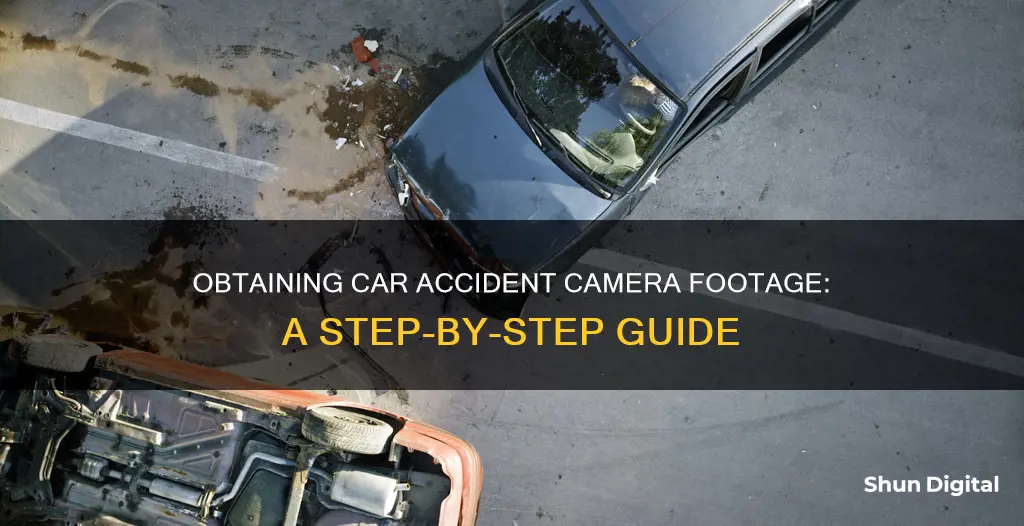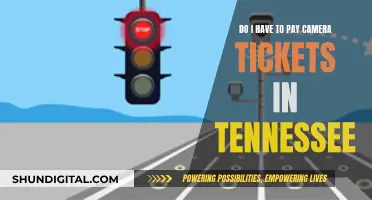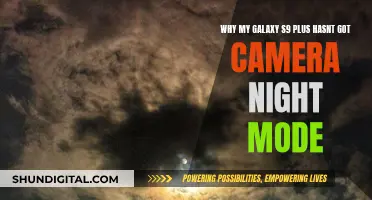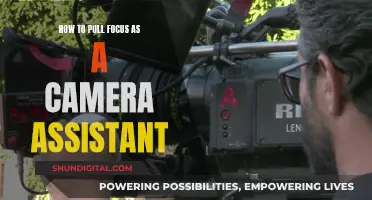
Traffic camera footage can be crucial evidence in the aftermath of a car accident. It can help determine the cause of the accident, identify a hit-and-run driver, and hold responsible parties accountable. However, obtaining this footage can be a complex and frustrating process. Here's a step-by-step guide on how to request and obtain camera footage of a car accident:
- Identify the location of the traffic camera: Find out where the traffic camera that may have captured the accident is located. This can be done by reviewing the police report or contacting the local police department or the Department of Transportation.
- Determine the jurisdiction of the camera: Figure out who owns and operates the camera. It could be the local police department, the Department of Transportation, or a private company.
- Contact the appropriate agency: Reach out to the agency responsible for the camera to request the footage. Provide details such as the date, time, and location of the accident. Be persistent but polite in your follow-up calls or emails.
- Review the footage: Once you receive the footage, review it carefully. Take note of any details that may help determine the cause of the accident, such as vehicle positions and speeds.
- Seek legal advice: If you're unsure about your next steps, consult an experienced car accident attorney. They can help you understand your rights and obligations and advise you on effectively using the footage.
It's important to act quickly when requesting camera footage, as agencies have varying retention policies for their footage. Some may keep it for a few days, while others may store it for several weeks or months.
| Characteristics | Values |
|---|---|
| First Step | Identify the location of the traffic camera |
| Second Step | Determine the jurisdiction of the camera |
| Third Step | Contact the appropriate agency |
| Fourth Step | Request the video footage |
| Fifth Step | Review the footage |
| Sixth Step | Seek legal advice |
What You'll Learn

Identify camera locations
Identifying the location of the camera that may have recorded the accident is crucial when requesting camera footage. Here are some steps and tips to help you identify camera locations:
- Review the accident details: Before beginning your search, gather as much information as possible about the accident, including the date, time, and location. Knowing the specific location will help you identify nearby businesses or residences that may have had cameras recording the incident.
- Check for surveillance cameras: Look around the accident scene for any visible surveillance cameras mounted on buildings, poles, or other structures. These could be private security cameras, traffic cameras, or cameras operated by the Department of Transportation (DOT).
- Contact the local police department: The police may have accessed or collected footage from nearby cameras as part of their investigation. They can also provide you with a copy of the police report, which may contain details about the camera locations.
- Reach out to the DOT: The DOT often operates traffic cameras for monitoring road conditions and traffic flow. Contacting them can help you identify if any of their cameras captured the accident.
- Identify nearby businesses: Businesses often have security cameras installed, and the footage from these cameras can be crucial in car accident cases. Identify any businesses near the accident scene and contact them to inquire about their camera systems and the availability of footage.
- Check with local news organisations: Some news organisations install 24-hour cameras at significant traffic areas. If the accident occurred in such an area, they may have footage available online or upon request.
- Review social media platforms: In today's world, it is common for bystanders to record accidents on their phones and share them on social media platforms such as YouTube, TikTok, Twitter, or Facebook. Searching these platforms for relevant keywords or locations may lead you to useful footage.
- Dashcam footage: If you or any other drivers involved in the accident have dashcams, the footage from these cameras can provide valuable evidence. Even if you don't have a dashcam, it is worth asking other drivers if they had one and were recording at the time of the accident.
- Contact a lawyer: Obtaining camera footage after a car accident can be a complex process. Experienced car accident lawyers can help identify potential sources of camera footage and guide you through the process of requesting and obtaining the footage. They may also have resources and connections that can aid in locating relevant cameras.
Remember that time is of the essence when requesting camera footage, as many agencies and organisations have limited data retention policies, and footage may be overwritten or deleted after a certain period. Therefore, it is advisable to act quickly and take the necessary steps to identify camera locations and make your requests for footage as soon as possible.
Charging the Crosstour Action Camera: A Quick Guide
You may want to see also

Determine camera jurisdiction
Once you have identified the location of the traffic camera, the next step is to determine its jurisdiction. This is critical because it will help you identify who to contact to obtain the video footage.
Jurisdiction will depend on who operates the camera. Is it the local police department, the department of transportation, or a private company?
If the camera is located in a public space, it is likely to be operated by either the police or the department of transportation. For example, in Texas, the Texas Department of Transportation (TxDOT) and related government authorities operate surveillance cameras for research and security.
However, if the camera is located on private property, it is likely to be operated by a private company or the property owner. In this case, you would need to contact the property owner or the company directly to request the footage.
It's important to act quickly when requesting camera footage, as some agencies only keep videos for a short period, sometimes just a few days or weeks.
Camera Tickets: Are They Legal in the USA?
You may want to see also

Contact the relevant agency
Once you have identified the agency responsible for the traffic camera footage, the next step is to reach out to their representatives. The relevant agency could be the local police department, the Department of Transportation, or a private firm. All of these agencies have contact information available to the public.
Depending on the policies of the jurisdiction's government agency responsible for storing the traffic camera footage, you can typically contact them to request access to the traffic cam video via phone, email, or their website. You may have to download a form, fill it out, and send it back as an attachment or upload it to make the formal video record request.
You can contact these agencies directly or have a proxy, such as a lawyer, contact them on your behalf. While you do not need a lawyer to help you get traffic camera footage, it is highly advisable to seek a car accident attorney's help. A personal injury lawyer will have experience with these requests and can help you get a subpoena from the local court system if necessary.
When making your request, be prepared to provide details about the accident, including the date, time, and location. After you've made your request, follow up with polite emails and phone calls to ensure that your request is being processed. Some agencies may require you to provide a release form before they can release the video footage. This form may include a statement that you will not use the video footage for any other purpose other than your own personal use.
In addition, some agencies may charge a fee for providing the video footage, so be sure to ask about any fees before finalizing your request.
Exploring Maps: Activating Camera Mode on PC
You may want to see also

Make a formal request
If an informal request for camera footage of a car accident is denied, you may need to file a formal request. This process can be complicated and time-consuming, and you may need to consult a lawyer for assistance. Here are the steps you can take to make a formal request:
- Identify the location and jurisdiction of the camera: Determine the exact location of the camera that may have captured the accident. This information can be found in the police report or by contacting the local police department or the Department of Transportation. Then, establish the jurisdiction of the camera. Find out if it is operated by the local police, the Department of Transportation, or a private company, as this will determine who you need to contact to obtain the footage.
- Contact the appropriate agency: Reach out to the agency responsible for the camera to request access to the footage. You can usually do this by calling their official phone number, visiting the state's DOT website, or sending an email to a specific address. Some agencies may require you to fill out and submit a form to make the request.
- Provide necessary details: When making the request, be prepared to provide specific details about the accident, including the date, time, location, and any other relevant information. This information will help the agency narrow down the footage and locate the correct clips.
- Follow up on your request: Keep track of your request by periodically following up with the agency through polite emails or phone calls. This will help ensure that your request is being processed and will reduce the risk of delays or mistakes.
- Review the footage: Once you receive the footage, review it carefully. Pay attention to any details that may help determine the cause of the accident, such as vehicle positions, speed, and the behaviour of the drivers involved. Take notes and consider seeking legal advice if you are unsure about how to proceed.
- Be mindful of the storage period: Keep in mind that agencies have different policies regarding how long they store traffic camera footage. While some may retain it for several weeks or months, others may overwrite or delete footage within 24 to 72 hours. Therefore, it is crucial to make your request as soon as possible to avoid missing the opportunity to obtain the relevant footage.
Easy Steps to Play Back Your Car Camera Footage
You may want to see also

Follow up
Follow-up
After making your initial request for camera footage of a car accident, there are several follow-up steps you can take to increase your chances of obtaining the footage successfully. These steps include:
- Be persistent but polite: It is important to be persistent in your follow-up efforts. Don't be afraid to make multiple contacts with the relevant agencies or businesses. However, always maintain a polite and respectful tone in your communications.
- Keep detailed records: Take notes and save all correspondence related to your request. This will help you keep track of who you have contacted, when you contacted them, and what their responses were.
- Follow up regularly: Don't be afraid to follow up with the relevant agencies or businesses regularly. Send polite emails or make phone calls to inquire about the status of your request. This will help ensure that your request doesn't fall through the cracks and will show that you are serious about obtaining the footage.
- Be prepared for potential challenges: Obtaining camera footage can be a complex and time-consuming process. There may be bureaucratic hurdles or legal requirements that you need to navigate. Be prepared to provide additional information or documentation if needed.
- Seek legal assistance if necessary: If you encounter difficulties in obtaining the camera footage, consider seeking legal assistance. A lawyer can help you navigate the process, determine your legal rights, and represent your interests if necessary.
- Act quickly: Time is often of the essence when requesting camera footage, as footage may be deleted or overwritten after a certain period. The faster you act, the higher your chances of successfully obtaining the footage.
- Explore alternative sources of evidence: If you are unable to obtain camera footage, don't despair. There are other sources of evidence that may be available, such as dashcam footage, eyewitness accounts, police reports, and cellphone videos or photos taken by passersby. These alternative sources can still provide valuable evidence to support your claim or case.
Remember that obtaining camera footage of a car accident can be a crucial piece of evidence for insurance claims, lawsuits, or personal injury cases. By following up on your initial request and taking persistent, proactive, and well-informed actions, you can increase your chances of successfully obtaining the footage you need.
How to Insert Batteries into Your FinePix S8200 Camera
You may want to see also
Frequently asked questions
You can review the police report or contact the local police department or the Department of Transportation to identify the location of the camera that may have captured the accident.
You can speak to the property owner and request the footage, but they are not legally obligated to provide it. If the local authorities are involved, they may be able to help obtain the footage, or it may need to be subpoenaed in court.
First, identify which government agency owns the camera. Then, contact the agency to inquire about their process for releasing footage. Some agencies may require a subpoena or a request under the Freedom of Information Act.
You will typically need to provide details such as the date, time, and location of the accident. Some agencies may also require you to fill out a privacy release form and pay a small fee for the footage.







